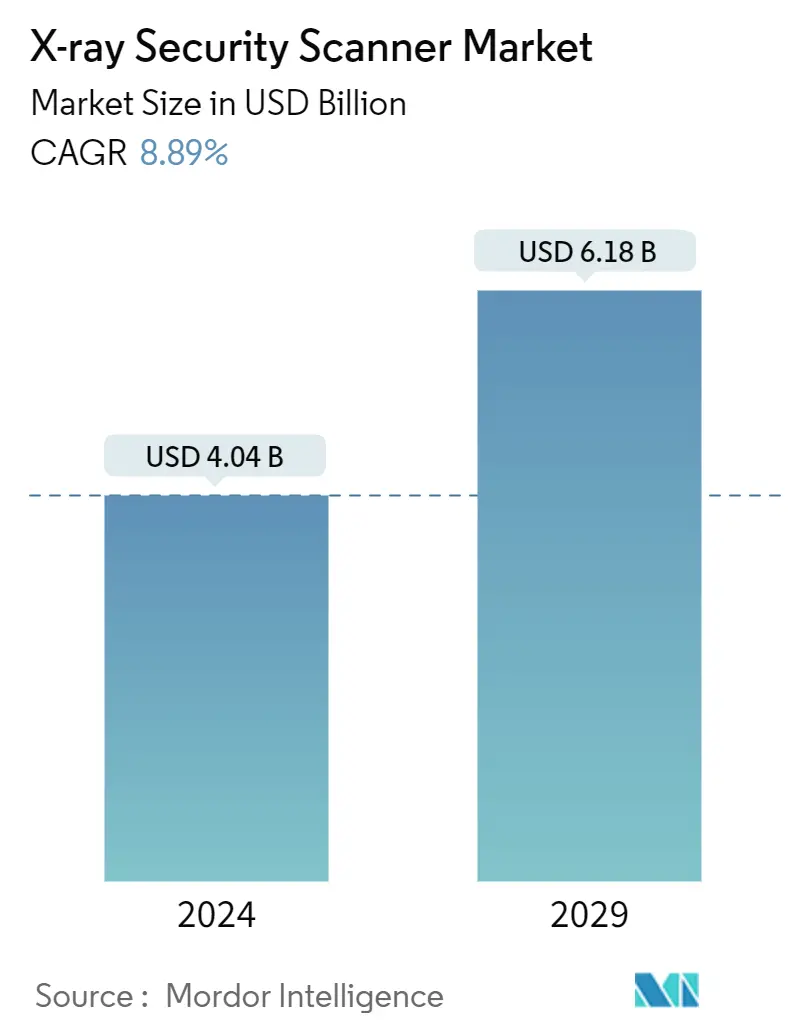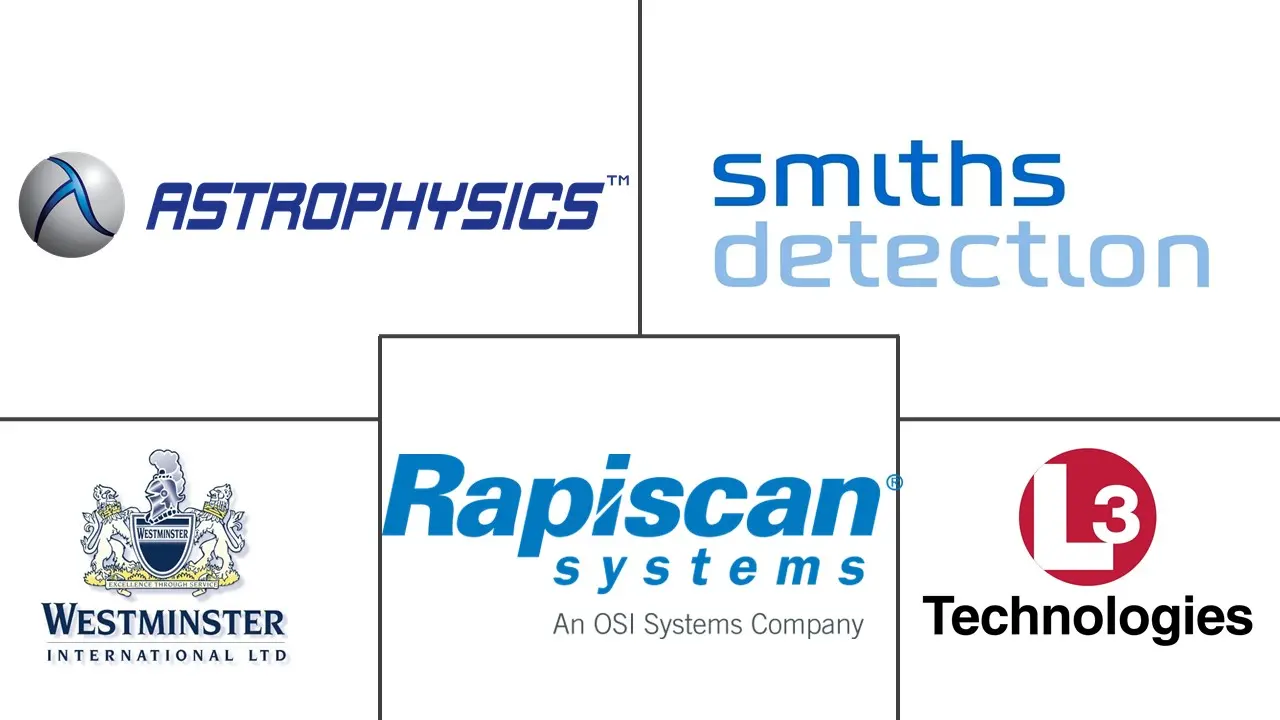Market Size of X-ray Security Scanner Industry

| Study Period | 2019 - 2029 |
| Market Size (2024) | USD 4.04 Billion |
| Market Size (2029) | USD 6.18 Billion |
| CAGR (2024 - 2029) | 8.89 % |
| Fastest Growing Market | Asia Pacific |
| Largest Market | Asia Pacific |
| Market Concentration | High |
Major Players
*Disclaimer: Major Players sorted in no particular order |
X-ray Security Scanner Market Analysis
The X-ray Security Scanner Market size is estimated at USD 4.04 billion in 2024, and is expected to reach USD 6.18 billion by 2029, growing at a CAGR of 8.89% during the forecast period (2024-2029).
The X-ray security scanners throw low-radiation penetration to detect metallic and non-metallic objects if hidden.
- With the growth of international trade in commodities and the emergence of fresh security risks across a range of industries, security has been elevated to the top of the priority list. A number of industries are expanding quickly, including event management, police enforcement, lodging and dining, and transportation. The need for X-ray security scanners in the market will increase as the volume of commodities traded is anticipated to increase. Various trade agreements have allowed for continued robust trading in North America, Europe, and Asia.
- The importance of public space security has increased due to an increase in terrorist activity around the world. Various terrorist organizations are enticing followers to target the countries supporting the military operations in Iraq and Syria in Western countries. The importance of intelligence and security systems has increased in light of the same. The x-ray security market is thus being driven by the increase in terrorist acts around the world.
- The rise of baggage scanners that use X-ray technology is also fueled by rising airport security costs. For instance, the Airport Authority of India (AAI) has agreed to pay a large sum of money to a foreign company to supply luggage scanners, which would be deployed at nine Indian airports, including Kolkata and Chennai. In the upcoming years, over USD 400 billion will be invested in airport developments in Asia-Pacific, followed by North America and Europe.
- Moreover, in the previous year, In order to support its Airport Self Service Checkpoint project for the US Department for Homeland Security (DHS), the Australian company Micro-X, which creates cold cathode X-ray technology for health and security markets, announced that it had received funding commitments of USD 23 million.
- However, the adoption of the X-ray security scanner industry has been significantly impacted by the spread of the new coronavirus. Since all of the countries' international borders were blocked as a result of the pandemic, the aviation industry has suffered the most. The travel ban was implemented to stop the virus's spread.
- The commercial adoption of X-ray security scanners has been significantly impacted by the proliferation of COVID-19. The epidemic caused the aviation industry to suffer more than any other sector as international borders started to close. The travel restrictions were put in place to stop the virus's spread. IATA reports that Europe experienced the largest YoY revenue passenger kilometer change on international routes (at -99%, followed by Africa at -98.8%). As a result, x-rays are increasingly less frequently used for passenger screening.
X-ray Security Scanner Industry Segmentation
X-ray body scanners and X-ray baggage scanners ensure the safety of passengers, assets, and facilities. Weapons, explosives, and narcotics are some contraband the security personnel has to deal with in a public place. An X-ray scanner identifies harmful organic, inorganic, and metal materials.
The X-ray security screening market is segmented by application (people and products (mail and parcel, cargo and baggage), end-user industry (commercial, law enforcement, aviation & transportation), and geography (North America [United States, Canada], Europe [United Kingdom. Germany, Italy, France, rest of Europe], Asia-Pacific [China, India, Japan, South Korea, Australia and New Zealand, rest of Asia-Pacific], Latin America [Brazil, Mexico, rest of Latin America] and Middle East and Africa). The market sizes and forecasts are provided in terms of value (USD) for all the above segments.
| By Application | ||||
| People | ||||
|
| By End-user Industry | |
| Commercial | |
| Law Enforcement | |
| Aviation and Transportation | |
| Other End-user Industries |
| By Geography | ||||||||
| ||||||||
| ||||||||
| ||||||||
| ||||||||
| Middle East and Africa |
X-ray Security Scanner Market Size Summary
The X-ray security scanner market is poised for significant growth, driven by increasing global trade and heightened security concerns. As international trade volumes rise, the demand for advanced security solutions, including X-ray scanners, is expected to grow. This demand is further fueled by the need to enhance security in public spaces due to rising terrorist activities worldwide. The transportation sector, particularly airports, is a major contributor to this market expansion, with substantial investments in airport security technologies. The development and deployment of X-ray scanners are crucial in safeguarding transportation hubs and urban infrastructure, especially in regions experiencing rapid urbanization and increased criminal activities.
The market is characterized by a concentration of key players, such as L3 Security and Detection Systems Inc., Westminster International Limited, and Rapiscan Systems Inc., who hold significant market shares. Recent advancements in X-ray technology, including the introduction of 3D imaging capabilities and dual-view scanners, are expected to drive further market growth. Despite the challenges posed by the COVID-19 pandemic, which temporarily impacted the aviation industry and reduced the frequency of passenger screenings, the market is anticipated to recover and expand. Ongoing investments in transportation infrastructure, particularly in Asia-Pacific, are expected to contribute to the market's rapid growth during the forecast period.
X-ray Security Scanner Market Size - Table of Contents
-
1. MARKET INSIGHTS
-
1.1 Market Overview
-
1.2 Industry Attractiveness - Porters Five Forces Analysis
-
1.2.1 Bargaining Power of Suppliers
-
1.2.2 Bargaining Power of Buyers
-
1.2.3 Threat of New Entrants
-
1.2.4 Threat of Substitutes
-
1.2.5 Intensity of Competitive Rivalry
-
-
1.3 Industry Value Chain Analysis
-
1.4 Assessment of Impact of COVID-19 on the Market
-
-
2. MARKET SEGMENTATION
-
2.1 By Application
-
2.1.1 People
-
2.1.2 Product
-
2.1.2.1 Mail and Parcel
-
2.1.2.2 Cargo and Baggage
-
-
-
2.2 By End-user Industry
-
2.2.1 Commercial
-
2.2.2 Law Enforcement
-
2.2.3 Aviation and Transportation
-
2.2.4 Other End-user Industries
-
-
2.3 By Geography
-
2.3.1 North America
-
2.3.1.1 United States
-
2.3.1.2 Canada
-
-
2.3.2 Europe
-
2.3.2.1 United Kingdom
-
2.3.2.2 Germany
-
2.3.2.3 Italy
-
2.3.2.4 France
-
2.3.2.5 Rest of the Europe
-
-
2.3.3 Asia-Pacific
-
2.3.3.1 China
-
2.3.3.2 India
-
2.3.3.3 Japan
-
2.3.3.4 South Korea
-
2.3.3.5 Australia and New Zealand
-
2.3.3.6 Rest of the Asia-Pacific
-
-
2.3.4 Latin America
-
2.3.4.1 Brazil
-
2.3.4.2 Mexico
-
2.3.4.3 Rest of Latin America
-
-
2.3.5 Middle East and Africa
-
-
X-ray Security Scanner Market Size FAQs
How big is the X-ray Security Scanner Market?
The X-ray Security Scanner Market size is expected to reach USD 4.04 billion in 2024 and grow at a CAGR of 8.89% to reach USD 6.18 billion by 2029.
What is the current X-ray Security Scanner Market size?
In 2024, the X-ray Security Scanner Market size is expected to reach USD 4.04 billion.

